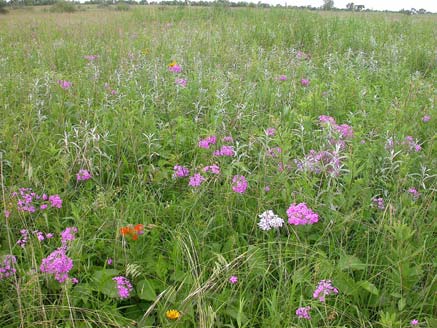Like politics all biofuels are local (or should be). Field work and computer simulations in Michigan and Wisconsin are helping biofuels researchers understand the basics of getting home-grown energy from the field to consumers. Preliminary results presented today suggest that incorporating native, perennial plants during biofuels production reduces emissions of greenhouse gases, improves water quality and enhances biodiversity. The results are part of an experimental effort to make biofuels economically and environmentally sustainable.

“If we can make biofuels sustainable in the Great Lakes region, then we can apply the same methods to make biofuel industries work in other regions” said Cesar Izaurralde of the Joint Global Change Research Institute in College Park, Md. a collaboration between the Department of Energy’s Pacific Northwest National Laboratory in Richland, Wash. and the University of Maryland.
Biofuels based on the food crop corn have come under criticism in recent years for contributing to high food prices and not reducing greenhouse gases enough. Now, researchers of the DOE Great Lakes Bioenergy Research Center are looking beyond food crops to be used as biofuel feedstocks. These “cellulosic biofuels” being studied include a range of herbaceous and woody species, including native prairie grasses.
How well these other biofuels will perform against greenhouse gas accumulation depends on the feedstock, how they’re grown, how the plant is converted to useful liquids, and where the industry is based. Something as simple as whether the crop needs to be planted every year or takes root can contribute to whether it’s an advantage over fossil fuels.
At the DOE Great Lakes Bioenergy Research Center, scientists are investigating which biofuels crops are best suited to take advantage of the conditions unique to that region — for example, which grow best in the soils and with the amount of water the region has available. An economic concern is that they do not interfere with the production of food crops.
“One of the objectives of the center is to develop ecological, agricultural, and life cycle practices that are economically viable and environmentally responsive for the production of biofuel crops” said Izaurralde.
Izaurralde presented an overview of the program, which is in its early stages, today at the American Association for the Advancement of Science annual meeting. For example, he and his colleagues are using computer models to explore regional production of biofuels in Michigan and Wisconsin. The computer simulations include weather and soil information, and many other production and economic factors. The researchers expect to find ways to deploy biofuel cropping systems that are profitable and environmentally sustainable.